jamiemcginlay
Joined: 20 Dec 2006
Posts: 930
Location: Glasgow
|
 Posted: Mon Feb 05, 2007 10:40 pm Post subject: Robert Tait McKenzie Posted: Mon Feb 05, 2007 10:40 pm Post subject: Robert Tait McKenzie |
 |
|
Doctor Robert Tait McKenze - The Scottish American War Memorial, Princes Street Gardens, Edinburgh.
Dr. Robert Tait McKenzie
Childhood and Education:
Robert Tait McKenzie was born in May 1867 in Ramsay township, Lanark County, Ontario; what would later become Almonte in Canada but at that time was virtually a pioneering community in the Ottowa Valley. His father was the Reverend William McKenzie a Presbyterian Minister, and mother Catherine Shiells McKenzie. William and Catherine were originally from Kelso, William had emigrated in 1858 to become minister of the Free Church of Scotland, Almonte, and later sent for his wife to be, Catherine, who was a student in Edinburgh.
1876 McKenzie’s father died when he was nine years old and it is said that it was the way in which friends, neighbours and parishoners rallied around to help the family (himself, his mother and two brothers and a sister) which made a deep impression on the young Robert, creating within him a strong sense of community spirit. The neighbourhood answered ‘The Call’ and built the family a home when they had to leave the manse.
1885 He was not outstanding at school but with the support of good teachers (the principal of the school at Almonte was a P.C. MacGregor and McKenzie was one of a number of outstanding men produced by this pioneer community) he succeeded in entering McGill University in Montreal as a pre-med student. At University he became increasingly interested in sports in which he excelled. He worked during his holidays to pay for his study, surveying in Manitoba and Alberta, working at his uncle’s lumber yard at Georgian Bay, and working in the Montreal Docks.
1889 Graduated in Art at McGill
Early Career:
1892 Graduated as a doctor and began his internship at Montreal General Hospital. He did however also continue with sports, excelling especially in swimming and fencing, and becoming a gymnastics instructor and was appointed the first ever Medical Director of Physical Training at McGill, while also holding positions as Instructor of Physical Culture and a Lecturer in Anatomy. He also became a regular lecturer on the anatomy of art, and a prolific pamphlet writer on physical and therapeutic exercise. When the instructor of the varsity gymnasium died the post was filled by McKenzie’s old friend from Almonte Doctor James Naismith (the man who went on to invent the sport of Basketball). Both men worked to promote the ideal of healthy mind and healthy body, and opposed professional sport. He also developed a circle of artistic and literary friends at this time and was a member of a ‘Pen and Pencil Club’ enjoying sketching and painting with watercolours with paintings accepted at the Royal Canadian Academy in 1898.
1893 Worked as ship’s surgeon for a steamship company working the Montreal to Liverpool route.
1894 He was asked by the Earl of Aberdeen to work as a swimming instructor for his two sons while staying at his summer house in Montreal. This led to McKenzie widening his contacts in some highly influential circles in both North America and Europe.
1895 Accompanied the Earl of Aberdeen’s sons on a visit to Scotland and England, and also a visit to France (he was fluent in French).
1896 Returned to private medical practice in Montreal. His interest in sculpture steadily increased and he became fascinated with the anatomy of athletes, their musculature and facial expressions which he began to model as part of his study of the changes which occur in an athlete’s body under stress. He also began a project measuring various points on the muscles and anatomy of 89 champion sprinters and began modelling plaster sculptures to record and illustrate these points. In later years his sculpture was sometime criticised for exactly this fault in being too analytical.
1899 Began relief sculpture with help of two noted sculptors Louis-Phillipe Hebert and George W. Hill while undertaking pioneering work in the treatment of sclerosis.
Despite convincing McGill University of the need for a physical education department the funds were simply not available and finally McKenzie applied for and secured the position of Director of Physical Education at the University of Pennsylvania which had modern facilities.
1904 Visited Europe meeting many important artists and sculptors. His work ‘Athlete’ was displayed at the Royal Academy in London. He continued to develop his sculpture modelling many small pieces and medals and developing a reputation in athletic sculpture.
1907 Continued to travel extensively and married another Canadian from Hamilton Ontario, Ethel O’Neil, in Dublin after meeting her on a voyage. Ethel was a talented poet and musician.
1910 Given his first commission ‘The Youthful Franklin’, an 8 foot bronze for the University of Pennsylvania.

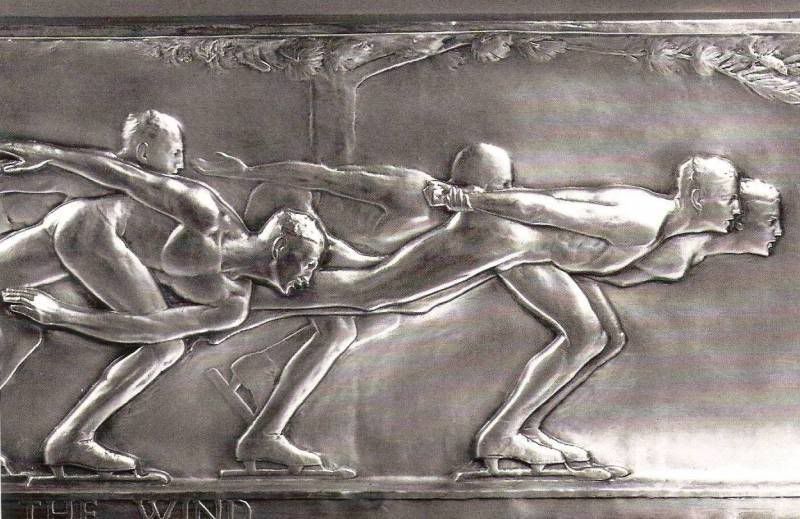
'Brothers of the Wind' 1925 is a good example of McKenzie's athletic relief sculptures which focus on a sense of movement.
1912 ‘The Joy of Effort’, a large bronze relief medallion set into the wall of the Stockholm Stadium. He was awarded the King’s Medal by the King of Sweden Gustavus V for his achievements in the field of athletic sculpture.
World War 1
1914 McKenzie’s mother died. He tried to secure a position in the Canadian Army Medical Corps and failed. Joined the British Army as a Canadian volunteer and applied for attachment to the Physical Training HQ Staff but the usual army red tape sent him on a course of physical education instead. This lasted only until his Colonel discovered that the man he was training had written the book! He was then made an inspector of training and toured training camps and hospitals and helped to develop training courses to raise recruits to basic fitness levels. McKenzie was a strong believer in the futility of trying to teach un-fit men marksmanship and bayonet fighting and developed a programme of exercise which required no equipment which he set out in his booklet ‘The making and Re-making of a Fighting Man’. He then served as a Lieutenant with the Royal Army Medical Corps and became involved in surgery, rehabilitation and physiotherapy work with wounded soldiers which led to his promotion to the rank of Major in command of the Heaton Park Medical Command Depot. His greatest achievement was in development of the rehabilitation of wounded servicemen by setting up a pilot scheme in Manchester to establish and dissipate the techniques and programmes to be used throughout the country. He later went to the U.S. to pass on his knowledge to the Americans after their entry into the war and in 1918 was appointed Inspector of Convalescent Hospitals for the Canadian Medical Service before going on to France to put his skills to the service of the French. His book ‘Reclaiming the Maimed’ was adopted as an official manual by the U.S. Army and Navy. Finally he also worked with fellow surgeon Dr. William Clark in the re-construction of the faces of badly wounded servicemen and helped to develop techniques for the modelling of cosmetic masks to hide severe facial wounds.
1919 ‘Blighty’ the bronze figure of a Seaforth Highlander now in the Queen’s Collection at Balmoral. After the war he became even more widely recognised and his works were exhibited throughout North America and Europe. He specialised particularly in executing medals for Olympic Games.
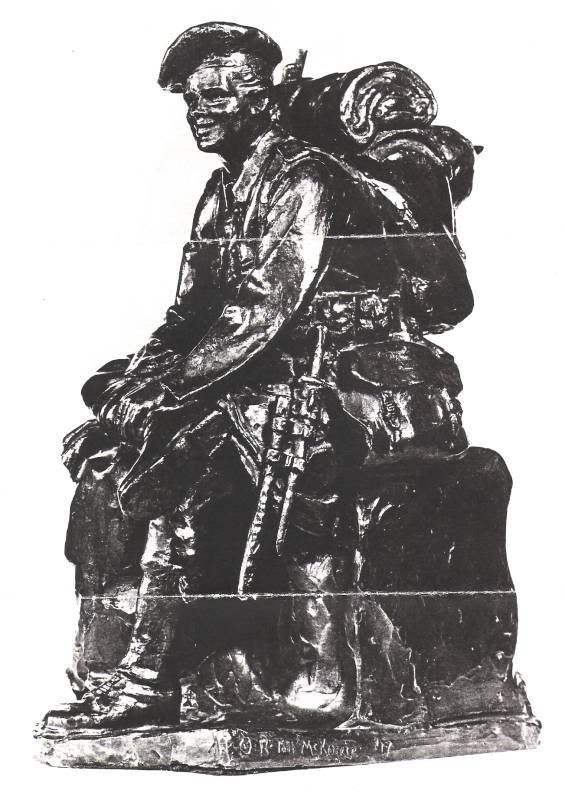


Blighty 1919, modelled from life in 1915 when McKenzie saw a group of Seaforth Highlander's enjoying a smoke as they went on leave 'with the mud of Flanders still on their boots'.
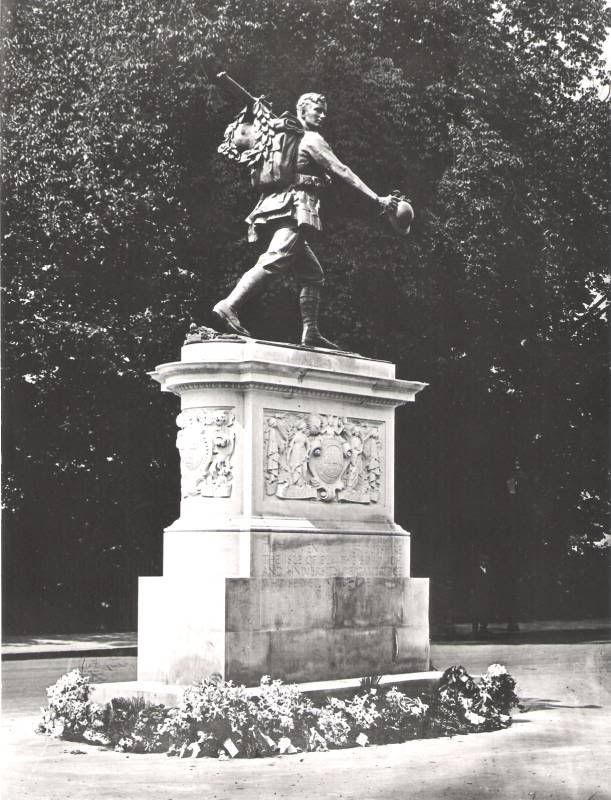
1921 ‘The Homecoming’ for the Cambridge War Memorial.
1923 ‘The Volunteer’, an 8’ high bronze for the Rosamond War Memorial, Almonte, Canada commemorating Alec R. Rosamond, head of the Rosamond Woollen Mills who had volunteered in 1914 and was killed at Courcellette.
The Scottish American War Memorial, Edinburgh:
In 1927 ‘The Call’, the Scottish-American war Memorial, Princes Street Gardens, Edinburgh. In 1924 the Saint Andrew’s Society of Philadelphia decided to create a tribute from Scottish-Americans to the Scottish soldiers killed in the war. According to John Buchan’s ‘History of the War’ a body of Scots troops were brigaded with the French under General Mangin at the Battle of Busancy and the General was so impressed by them that he had a cairn erected on the field to commemorate their valour. It was this story told by Cameron of Lochiel at a dinner that inspired the St. Andrew’s Society to pay a similar tribute to the Scottish servicemen.
McKenzie was president of the society and the commission was offered to him which he took up enthusiastically. The monument was to be funded by small contributions from Scots and people of Scottish ancestry from across the United States with fundraising by the Saint Andrew’s and many Clan Societies. McKenzie sailed for Scotland in 1924 to select a site and began work. The Scottish National War Memorial was under construction at the time and McKenzie opted for the site in Princess Street Gardens were his sculpture would look up at the Castle. McKenzie then returned to Philadelphia to begin work with his assistant Boris Blai and he chose a member of the Penn Football team Granville Carrel as the model. Carrel was also used as model for the bodies of the various figures on the background frieze, but the heads were based on Scots in Scotland (during WWII Carrel was in London serving as a Major in the U.S. Army Air Force and visited the memorial and was interviewed by ‘The Scotsman’ newspaper. Carrel ended WWII as a highly decorated officer). In 1926 McKenzie returned to Scotland, staying at Darnick Tower while commuting to Edinburgh to supervise the on-site work. The memorial was finally completed and cast by the Roman Bronze Works in Brooklyn before being shipped to Scotland. Craigleith stone was chosen for the construction of the monument and McKenzie worked with the on-site sculptor Alexander Carrick on the final erection of the memorial which was unveiled on 7th September 1927.
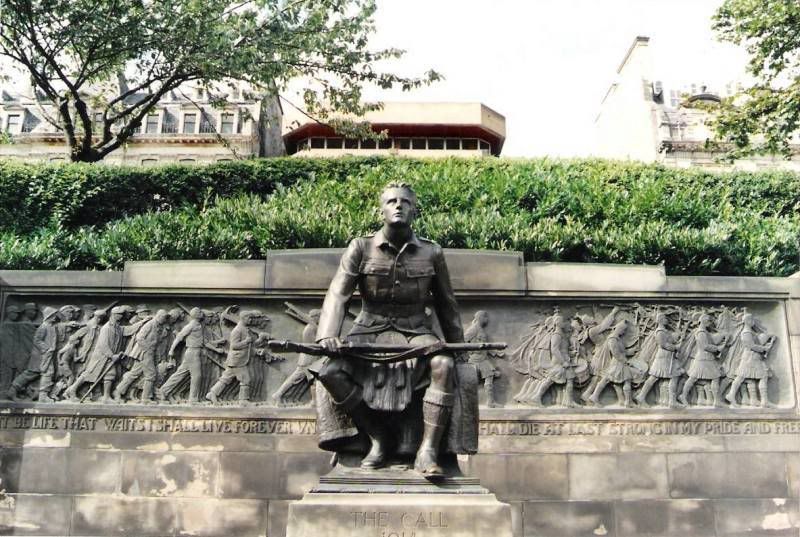
The memorial features the figure of a kilted youth with cap and rifle in hand responding to ‘The Call’ to arms seated on a pedestal. On the face of the pedestal the inscription reads:
The Call
1914
A Tribute
From men and women of Scottish blood and sympathies
In the United States of
America
To Scotland
‘A people that jeoparded their lives until the
Death in the high places of the field’ Judges V.18
The 25’ frieze on the wall behind portrays ‘The Response’ which is divided into three sections illustrating the volunteers who come from every walk of Scottish life, a recruiting party and finally a pipe band.
The inscription below the frieze reads:
If it be life that waits,
I shall live forever unconquered,
If death, I shall die at last
Strong in my pride and free’
Taken from the poem ‘My Creed’ by Lieutenant E.A. MacIntosh of the 51st Seaforth Highlanders who was killed in action in 1917 and had been decorated with the Military Cross.
At the unveiling ceremony the American Ambassador A.B. Houghton made a speech saying:
‘Today we commemorate the Great War with the figure of a common soldier – one youth separated from the thronging files of recruits pressing on from behind – one youth within sound of the pipes and drums and within sight of the old castle on the hill – one son of Scotland from a mansion or a manse or a mine, from a farm or a factory, from a Glasgow close or an Edinburgh lane – it mattered not. For he came from all of these. He kept lonely company with his own soul in a tank or in a trench, on the sea or in the sky. And he went to his death alone’

The Scottish American war memorial is a fine example of McKenzie’s work. He had a lifelong fascination with the capture and portrayal of physical movement. With ‘The Call’ McKenzie used this life-long study in an attempt to symbolise the high ideals which motivated volunteers through capturing that first instant of physical movement as the soldier stirs from his seat, moving from repose to action (he had employed a similar approach with his Rosamond War Memorial in Canada). McKenzie also uses movement in the background frieze for ‘The Response’, but in a different way. On this occasion it is the rhythmic sense of movement created by the marching figures that draws the viewers eye from left to right across the scene, almost like reading a piece of music, moving from the undisciplined but very humane group of civilians with their children and dogs leaving their peacetime occupations, on through their first uncertain steps as they begin training and marching, and on to the disciplined marching of the leading soldiers and the wilder rhythm of the bandsmen. The clever layering of some of the soldiers and bandsmen with the legs and arms of the men behind protruding and overlapping beyond those of the man in front creates something akin to a strobic effect which further enhances the sense of rhythm and movement. McKenzie was very proud of the monument and afterwards considered it to be his finest work. Certainly the use of such a subtle gesture of the volunteer, starting from his seat, on such a prestigious memorial showed some courage and conviction in his work. On the other hand it did come in for some criticism, one newspaper describing the soldier as 'prettyfied' and in using an American for his model I feel he ended up with a rather Amercian face on his sculpture of the volunteer, but thats just a personal opinion.
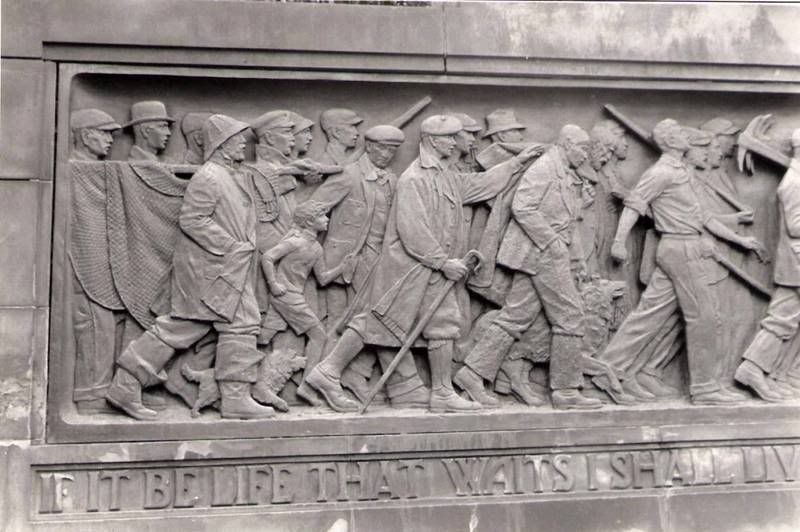

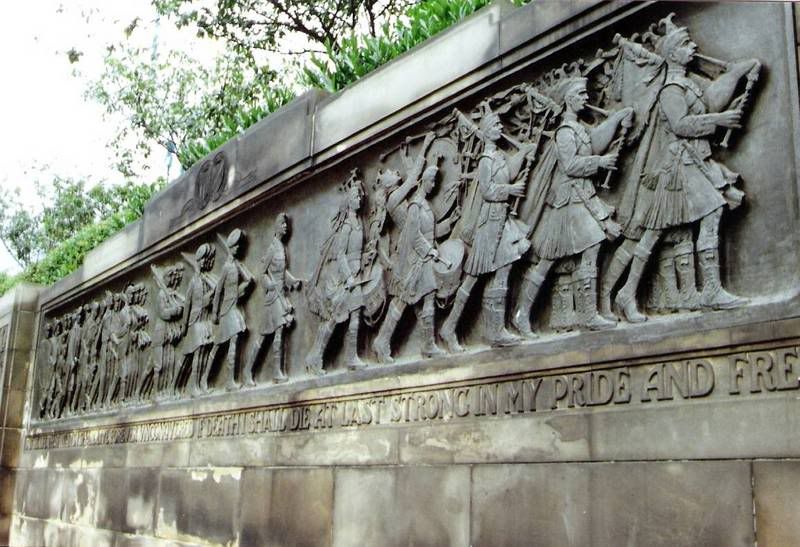
Later Life:
1930 McKenzie an old mill near his birthplace of Almonte and converted this into a summer home and studio. This has now been turned into a memorial museum to R. Tait McKenzie’s life and works.
1931 A special exhibition featuring sixty seven of his works was held at the Los Angeles Olympics.
1932 General James Wolfe, a 10’ high bronze statue for Greenwich Royal Park, London.
1936 Exhibited at the Berlin Olympics.
1938 On 28th April he died suddenly and without warning of a heart attack at home at the age of 70 in Philadelphia. The news shocked all of Canada. In his will McKenzie ordered that he was to be buried in Canada, but his heart was to be removed and buried in Scotland. It was placed in an oak casket which is set into the external east facing wall of St. Cuthbert’s not far from the Scottish American War memorial in Princes Street Gardens. When McKenzie’s family approached Alexander Carrick for a suitable memorial. Carrick suggested that McKenzie’s memorial was his work, and then proposed that he simply carve McKenzie’s monogram with which he signed many of his works onto a small piece of Craigleith stone left over from the Scottish American Memorial and set this into the wall of St. Cuthbert’s to mark the last resting place of his heart.
1940 Posthumous memorial exhibition of his works held at the University of Pennsylvania.
Bibliography:
Country Life, Vol. LXII – NO. 1598, Saturday September 3rd 1927
Edinburgh Evening News, Monday 19th October 1987 (Granville Carrell)
The Studio Vol. LXXX, 1920, p.133 - 139
The Studio Vol. LXXXII, 1921, P.75 (Cambridge Memorial)
The Studio 1922, p.111 (Cambridge Memorial)
The Glasgow Herald, 8th September 1938, p.7 (Internment ceremony of heart)
The Scots Magazine ‘The Story of the Call’ 1927, by Norval Scryngeour
The Life of a Remarkable Man, reprinted from the Canadian Army Journal, January 1955.
Robert Tait McKenzie 1867-1938, Sculptor of Athletes by Richard Graburn, The Nickle Arts Museum, Calgary. |
|













